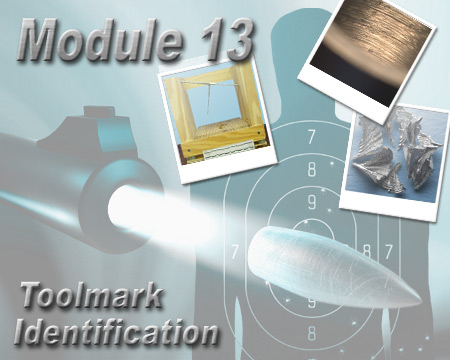Home | Glossary | Resources | Help | Contact Us | Course Map
Archival Notice
This is an archive page that is no longer being updated. It may contain outdated information and links may no longer function as originally intended.
| Author: John H. Dillon, Jr. |
| Jack Dillon earned a B. S. from the United States Naval Academy and an M. Ed. from the University of Virginia. Commissioned in the United States Marine Corps in 1964, he attained the rank of Captain of Marines. Appointed a Special Agent, FBI, in 1970, he investigated diverse criminal violations, including organized crime, bank robberies, extortions, and kidnappings. In 1976 he received orders to the Firearms/Toolmarks Unit of the FBI Laboratory for training as an examiner, where he evaluated evidence and provided on-site field support in domestic cases, as well as abroad. He also designed and taught basic and management-level forensic courses at the FBI Academy, Quantico, Virginia, 1982-1988. Jack retired from the FBI as Chief of the Firearms/Toolmarks Unit in 1994, and continues to consult in forensic firearm cases and in training design and delivery. |
Introduction
Toolmark examinations and comparisons represent the core area of study for firearm and toolmark examiners. The conceptual and practical aspects of toolmark identification provide the skills necessary for firearms identification; firearm identification is a specialized subset of toolmark identification. There are potentially many more variables in terms of the marks to be examined.
As a forensic discipline, microscopic comparison and potential identification of striated or impressed toolmarks as having been made by the same tool are central to the identification of toolmarks.
The foundation for this technique is based on the following concepts:
- A tool is defined as the harder of two objects which, when brought into contact with each other, results in the softer object receiving a toolmark.
- Tools (e.g., screwdrivers, firearms, bolt cutters, etc.) will bear unique microscopic characteristics due to the manufacturing processes they undergo and use and abuse.
- These characteristics will mark surfaces (e.g., locks, cut wires, fired bullets, etc.) with class and individual characteristics.
- These class and individual characteristics are reproducible and identifiable with a particular tool.
Objectives
At the conclusion of this module the student should be able to do the following:
- Identify the common metal shaping operations used in the manufacture of tools, including
- common cutting operations based on the formation of metal chips,
- common metal forming operations not involving cutting,
- modern metal machining techniques.
- Describe the following concepts as they relate to the formulation of conclusions relating to toolmark examination and comparison:
- Class characteristics
- Individual characteristics
- Subclass characteristics
- AFTE Theory of Identification
- Pattern matching
- Sufficient agreement
- Best known nonmatch
- Consecutive matching striae (CMS)
- AFTE Range of Conclusions
- Explain the differences between the terms
- identification,
- inconclusive,
- elimination,
- unsuitable.
- Itemize the essential items of equipment necessary to carry out the comparison microscopy of toolmarks.
- Summarize the prerequisites that must be addressed prior to initiating any examination or comparison of toolmarked evidence.
- Describe the examination protocol for the microscopic comparison of the class and individual characteristics represented by toolmarks.
- Describe the examination protocol for the examination and comparison of fracture marks.
AFTE Knowledge and Ability Factors
| 14. | Knowledge of how to properly document evidence and analytical results (through notes, sketches, photography, reports, etc.) |
| 15. | Knowledge of the techniques and procedures used to properly mark evidence (when appropriate) |
| 26. | Knowledge of definitions of class, subclass, and individual characteristics and the differences between them |
| 27. | Knowledge of the sources of class, subclass, and individual characteristics |
| 38. | Knowledge of how and when to use various vises, clamps, and restraining devices |
| 114. | Knowledge of proper use of tools and materials for test marks |
| 116. | Knowledge of the interactive nature of the tool/toolmark process and the transference of class, subclass, and individual characteristics |
| 117. | Knowledge of impressed (static) vs. striated (dynamic) toolmarks |
| 118. | Knowledge of the best agreement possible in situations of known nonmatches when comparing toolmarks |
| 119. | Knowledge of the principles of preparing test marks and the effects of test materials in the production of testfired cartridge components and toolmarks for comparison |
| 4. | Ability to select the appropriate casting materials (casting of bullets/toolmarks) |
| 17. | Ability to select proper casting material and technique (mentioned above) |
| 19. | Ability to understand and interpret technical data output from laboratory instruments |
| 21. | Ability to recognize discrepancies or inconsistencies in analytical findings and determine their cause and significance |
| 23. | Ability to recognize the limitations of tests and interpretations |
| 41. | Ability to identify reloaded ammunition as having been assembled by the same equipment by determining that specific reloading tool(s) came in contact with cartridge components |
| 48. | Ability to recognize and properly align reproducible striae arrays sufficient for identification purposes |
| 49. | Ability to recognize, determine the source of, and differentiate between class, subclass, and individual characteristics on bullets, cartridges, cartridge cases, and in nonfirearm-related toolmarks |
| 53. | Ability to distinguish between the quality and quantity of matching striae in a true identity and that observed in known nonmatches |
| 57. | Ability to recognize any manufacturer-induced characteristics |
| 71. | Ability to make determinations in toolmark comparisons (both firearm and nonfirearm toolmarks) regarding: identifications, exclusions, and inconclusives |
| 72. | Ability to recognize patterns (profiles, etc.) produced by various tool-working surfaces |
Additional Online Courses
- What Every First Responding Officer Should Know About DNA Evidence
- Collecting DNA Evidence at Property Crime Scenes
- DNA – A Prosecutor’s Practice Notebook
- Crime Scene and DNA Basics
- Laboratory Safety Programs
- DNA Amplification
- Population Genetics and Statistics
- Non-STR DNA Markers: SNPs, Y-STRs, LCN and mtDNA
- Firearms Examiner Training
- Forensic DNA Education for Law Enforcement Decisionmakers
- What Every Investigator and Evidence Technician Should Know About DNA Evidence
- Principles of Forensic DNA for Officers of the Court
- Law 101: Legal Guide for the Forensic Expert
- Laboratory Orientation and Testing of Body Fluids and Tissues
- DNA Extraction and Quantitation
- STR Data Analysis and Interpretation
- Communication Skills, Report Writing, and Courtroom Testimony
- Español for Law Enforcement
- Amplified DNA Product Separation for Forensic Analysts



